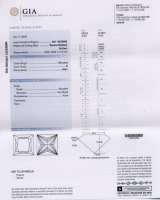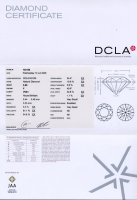Diamond Grading Certificates
[ Edit This Page ] [ Report This Entry ] [ View History ]
Diamond grading certificates, also called reports, essentially list and describe a diamond's characteristics in terms of the The 4Cs. However, in reality, they are far more detailed than just listing four characteristics, as most not only list carat weight, colour and clarity, but also proportions, fluorescence, polish and symmetry.




Equipment Used
Whilst the exact equipment will vary from lab to lab, typical lab equipment includes:
- Scales to measure carat weight
- Powerful microscopes
- Master stones or a colormeter for judging colour
- Equipment to determine a diamond's authenticity, such as Diamondsure and Diamondview or an HRD D-Screen.
- Proportion Analysers
- Ultra violet lighting to determine fluorescence
- Laser inscription equipment
- Light return analysers, such as the Brilliancescope
- Spectrophotometers
Differences Between Certificates
Not all certificates are the same, as they all report on different characteristics and even use different metrics.
For example, The AGS has recently introduced a light performance grade for round brilliants and princess cuts, something that is unique amongst the larger laboratories. In addition, The GIA only report table and depth sizes for fancy cut diamonds, whilst The DCLA report on all proportions for fancy cuts, but leave out a symmetry grade.
In addition, there are two competing grading scales. The GIA is by far the most common, whilst some laboratories such as The HRD and The DCLA conform to IDC rules, which use the slightly different CIBJO scale for grading clarity.
Accuracy
Whilst there are some reports of grading inaccuracies by laboratories, laboratories can increase their accuracy by grading diamonds multiple times by different graders. In fact, both The GIA and laboratories compliant with IDC rules grade diamonds three times by different graders.
Anonymity is also important as it ensures grading is objective, and not subject to favouritism or even bribes.
Price Differences
Due to accuracy and reputation, different grading certificates attract different premiums.
Polished Prices state that diamonds with certificates from laboratories such as EGL and IGI sell for up to a 6.5% discount over GIA certified diamonds, whereas The AGS certified diamonds sell for a 2% premium over GIA certified diamonds.
state that diamonds with certificates from laboratories such as EGL and IGI sell for up to a 6.5% discount over GIA certified diamonds, whereas The AGS certified diamonds sell for a 2% premium over GIA certified diamonds.
The 2004 Pricescope Grading Survey compared price differences between well cut diamonds with different grading certificates and found even higher differences in price between laboratories.
compared price differences between well cut diamonds with different grading certificates and found even higher differences in price between laboratories.
Robert Hensley of diamondhelpers.com stated that:
It should also be noted that whilst The GIA and HRD are non-profit organisations, for-profit laboratories need to make a profit in order to continue operations. It is therefore possible to issue "soft gradings" in order to attract merchants.
Benefits For The Consumer
There are many reasons why diamond grading certificates are beneficial for consumers. For example:
- They ensure the diamond you get is what you pay for.
- They ensure that the diamond you get back from a jeweller for setting or repairs is your diamond.
- They are worth more, and are easier to sell.
On the other hand, diamond grading certificates may artificially inflate the price of a diamond, as a consumer could buy an uncertified diamond at a cheaper price and submit it for certification themselves. However this method may not be practical, as it does require a lot of trust in the merchant and even more knowledge of diamonds.